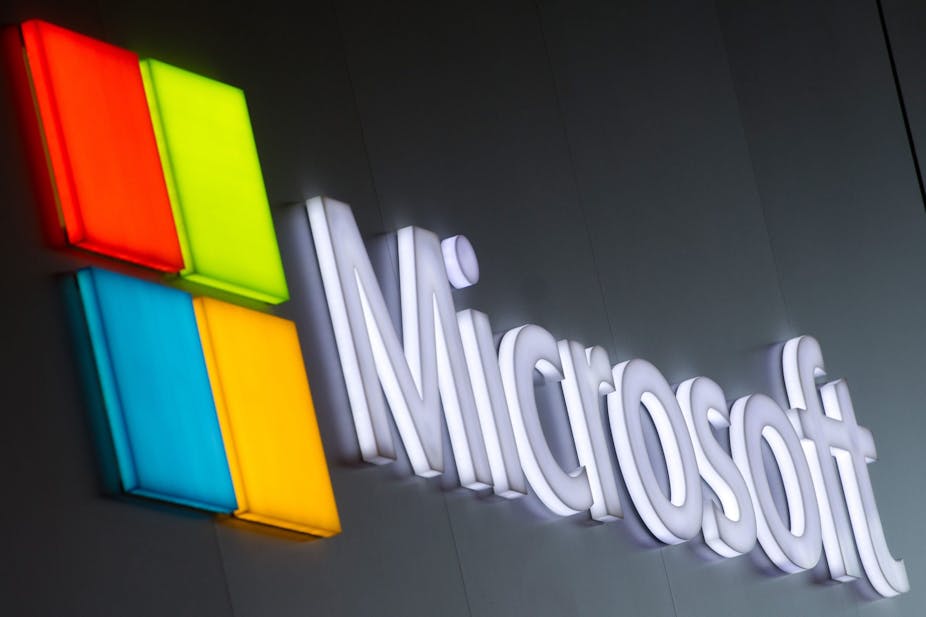When large corporations can shrug off financial penalties and seem indifferent to reputational damage because they’ve captured the consumers, you might wonder about the true cost of broken promises in high-tech global markets.
That’s one question arising from the announcement that the European Union competition regulator has imposed a US$732 million penalty on Microsoft, equivalent to 1% of the software giant’s annual sales. (The main Australian regulator, by comparison, has a budget of around A$180 million.)
The EU indicated that Microsoft had failed to uphold the terms of a 2009 antitrust settlement, in which Microsoft promised that it would provide European Windows users with alternative browser options. In an outbreak of collective amnesia, Microsoft forgot to comply and the regulator forgot to check until prompted by Microsoft’s competitors. The penalty signals that Europe’s regulators are getting tough. It’s a message to Google and Facebook, which dominate the EU markets for online search and social networks, pay derisory amounts of tax and have been unresponsive to requests by provincial, national and EU-wide regulators.
The penalty is an echo of the “Microsoft Wars” - major litigation over software - of the last decade, in which competitors complained that Microsoft was abusing a tacit monopoly and the US government had indifferent success with antitrust litigation.
High-tech enterprises – vendors of computer software and devices, pathology laboratory equipment, even photocopiers – are often able to exploit markets because of consumer lock-in. Consumers may be reluctant to shift to a competitor because of switching costs — in other words, they’ve invested so heavily in familiarisation and training in use of a particular product/service that a move is not viable. Use of a cheaper part from a competitor may be impractical, with a product for example being designed so that only ‘genuine’ parts (with a premium price and protection under patent law) fit as a replacement.
Software design may mean that applications from a competitor perform poorly, do not work at all or cannot be integrated. That is particularly important in enterprise computing, where corporations and government agencies have invested hundreds of millions in large scale systems and can not switch without major disruption to a new service provider or add a specialist product with superior attributes. Some products may be inferior to those of a corporation’s competitors but are chosen by consumers for compatibility: they are de facto standards within an industry or region. Consumers are formally free to use competing products, which may even attract substantial documentation and other support, but in practice are strongly inclined to use the same product – inferior or otherwise – that is used by their peers.
Litigation in the US and EU against Microsoft involved claims that the corporation was abusing its market dominance – most personal users and many corporate users of “office” software rely on Microsoft – by making it difficult to install a non-Microsoft web browser. Testimony in the litigation demonstrated that Microsoft was indeed seeking to disadvantage Netscape as a competitor and had sought to inhibit the growth of Apple, its major rival in the personal desktop software market. Netscape has now disappeared. Google enjoys a dominance in search that rivals Microsoft’s “ownership” of word processing or and the position of SAP and Oracle in enterprise computing. It doesn’t have a formal monopoly (many people use “alternative” browsers such as Firefox and Google’s Chrome). It has accordingly argued that it dominates its markets because it is better rather than because it is bad. In practice, however, “search” for most people means Google, and the corporation accordingly leverages its position through expansion in software and hardware.
What’s the best response when wealthy corporations engage in price gouging (goods/services are egregiously over-priced but the consumer is locked in) or stifle competition and thereby eliminate benefits attributable to innovation?
Those questions are not new. They underpin, for example, criticism of patent law over the past 130 years. Answers aren’t easy. One response has been for regulators to leave the market alone, on the basis that monopolies foster competition that benefits specific consumers and the economy at large. Only a handful of large corporations have survived for more than three generations and as the recent unbundling of News Corp demonstrates even dominant enterprises may shrink or disappear.
Another response has been vigorous enforcement of existing law through litigation against cartels (evident in action by the ACCC) or more broadly against “anti-competitive behaviour”. Governments and educational institutions, as leading consumers, have paid lip service to encouraging market diversity through use of open source software, but in practice rely on the usual suspects such as Microsoft. A more effective response – and why the EU penalty is significant – is to articulate clear competition policies and then insist that corporations abide by them.
Competition policy is a creature of fashion and ideology. We no longer break up monopolistic enterprises such as Standard Oil or IG Farben. As in the case of the unsuccessful anti-trust action against IBM, we are reluctant to tie them up in red tape pending the emergence of real competitors. We can however use administrative sanctions, such as the EU penalty, to encourage compliance with promises.

